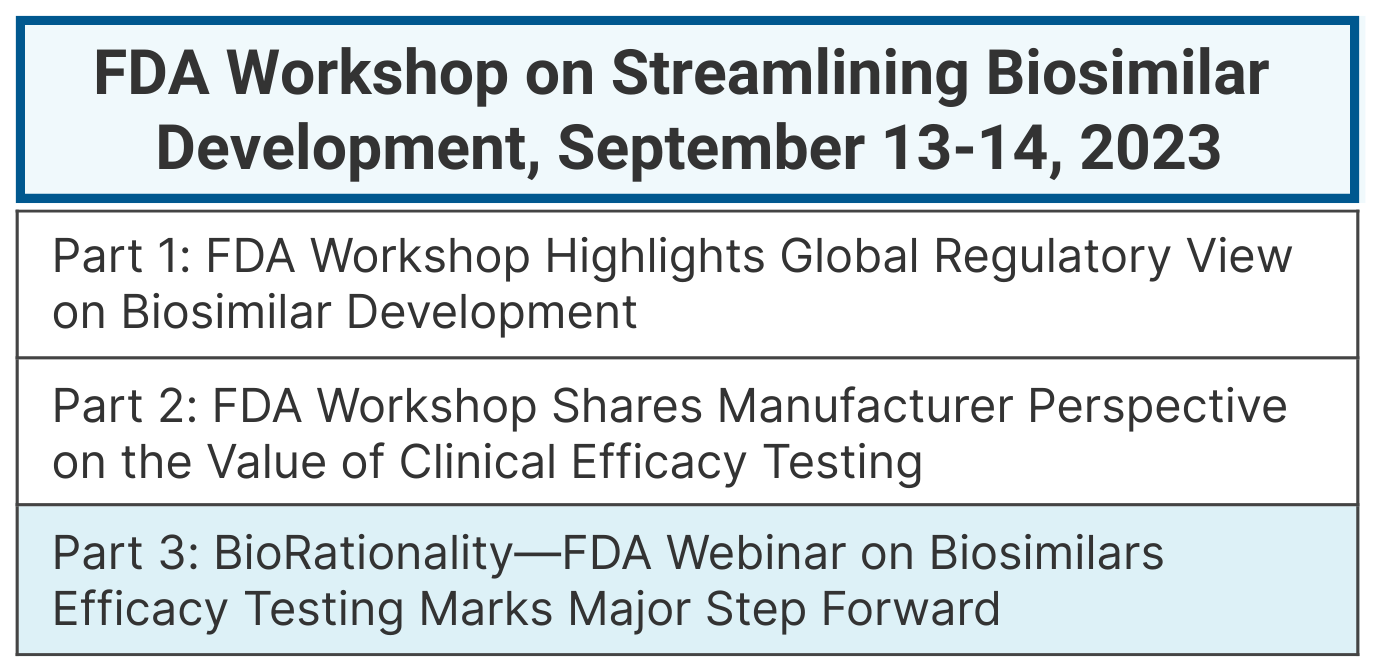- Bone Health
- Immunology
- Hematology
- Respiratory
- Dermatology
- Diabetes
- Gastroenterology
- Neurology
- Oncology
- Ophthalmology
- Rare Disease
- Rheumatology
Part 3: BioRationality—FDA Webinar on Biosimilars Efficacy Testing Marks Major Step Forward
In the final part of a 3-part series, Sarfaraz K. Niazi, PhD, gives his take on the FDA's recent workshop dedicated to streamlining biosimilar development and his opinion on what the industry can learn from the webinar presenters.

Click here for Part 1 and Part 2.
The FDA conducted its long-awaited webinar, “Increasing the Efficiency of Biosimilar Development Programs—Reevaluating the Need for Comparative Clinical Efficacy Studies (CCES),” on September 12-13, 2023. The conference was organized under the International Pharmaceutical Regulators Programme. On the first day, seven regulatory agencies presented their views, followed by over 60 questions submitted, and on the second day, the developers got a chance to present their views.
First came the UK’s Medicines and Healthcare products Regulatory Agency (MHRA), with the most positive response that no CCES are required, a change that came after they split from the European Union. They have received 20 applications but faced a situation where the developers were eager to conduct such studies, planning to co-submit their applications to European Medicines Agency (EMA) and FDA. MHRA suggested harmonizing the guidelines with the FDA and EMA but offered the complexity of achieving it. However, it was informed that the FDA and EMA are cooperative in submitting biosimilars and any product as detailed in the FDA and EMA websites.
The WHO concurred with MHRA but with a twist: “State-of-the-art analytical and functional testing and robust PK [pharmacokinetic] and PD [pharmacodynamic] studies are sufficient to demonstrate biosimilarity, whereas in vivo animal studies and larger confirmatory efficacy and safety studies are generally not needed.” The statement that “large” studies are not needed, leaves the room for the requirement of smaller studies.
A World Health Organization (WHO) survey of 20 countries concluded that biosimilars approved in certain countries, including Africa, South America, the Middle East, and Southeast Asia, might not have been approved following a strict regulatory process as recommended by WHO 2009 guidelines. The WHO is not a regulatory agency, but its guidelines are followed by its 194 member states. A significant statement by the WHO was the reason for changing the designation from similar biotherapeutic products to biosimilars as they wanted to expand the scope to nontherapeutic biologic products, such as recombinant plasma products and soon mRNA vaccines.
Experts have been calling for an end to animal toxicology and clinical efficacy testing for years, claiming that new evidence proves that these tests do not provide any additional data on the safety and efficacy of a biosimilar compared with pharmacokinetic (PK) and pharamcodynamic (PD) analyses.

The EMA said that its default remains CCES but not to justify “substantial” differences in quality attributes. EMA continues to support the obsolete non-inferiority design and recommends “adequately powered” studies without recognizing that it is impossible. PD markers as a surrogate of efficacy are acceptable. It has, however, approved 2 eculizumab biosimilars based on small PD studies in patients with paroxysmal nocturnal hemoglobinuria using efficacy based on lactate dehydrogenase/breakdown of red blood cells. This is not waiving CCES but designing to meet the efficacy biomarkers. EMA is planning to issue a concept paper soon to clarify this thinking.
Health Canada requires CCES but allows waivers when PD markers are available that can be requested but not at an early stage, creating much misunderstanding; 9 biosimilars were approved with no CCES. It brought the question of equivalence margin and non-inferiority testing but did not share its perspective on these studies. It admitted that equivalence margins can create difficulties and result in interpretation difficulties. Still, it did not admit that regardless of the margin selected, it will always be greater than the actual margin based on analytical assessment. New guidelines are expected in 2024.
Japan’s Pharmaceuticals and Medical Devices Agency remains committed to CCES, stating that, “it will be difficult to demonstrate the comparability of a biosimilar with the reference product only based on the data on quality attributes and the results of nonclinical studies,” but seems open to if PD available seven biosimilars with clinical efficacy biomarkers approved without CCES—a ranibizumab biosimilar was approved without PK study. Post-market studies are still required.
The Ministry of Food and Drug Safetyfrom the Republic of Korea has product-specific guidelines. CCES are generally expected unless quality and PK/PD with clinical markers are available. Lists CCES as phase 3 studies incorrectly. It approved a trastuzumab biosimilar that failed CCES after removing the data. Patients were given an antibody-dependent cell-mediated cytotoxicity variable reference product. Teriparatide (not a protein in the United States) agreed with the PK study—but more post-market data is required.
The FDA has classified its approvals into 3 types of approvals for biosimilars:
- PK and PD data: insulin glargine
- PK and PD/antidrug antibodies (ADAs)/safety data: filgrastim, pegfilgrastim, epoetin-alfa, and natalizumab
- PK and Efficacy/ADAs/safety data: the rest of monoclonal antibodies and etanercept.
The FDA now suggests collecting clinical data in tandem with completing analytical assessments since the stepwise approach is impractical. While the FDA recommended hypothesis testing based on statistical equivalence to establish safety and efficacy, it failed to acknowledge that such testing will always lead to no difference. The FDA used the “golden rule” terminology for CCES, which impedes realizing that CCES is not a “golden rule.” The FDA also failed to share its recent suggestions for discovering PD biomarkers using omics technologies, which is impractical. Since PD markers, not the efficacy markers listed as PD markers, are not correlated with clinical response, meeting failing compliance has no relationship to CCE conformance. The best PD marker is the PK study, and the analytical assessment is strengthened with receptor binding; immunogenicity is better tested in healthy, non-compromised subjects.
The Q&A session was less organized and failed, in my opinion, to bring the critical issues of harmonizing the guidelines and realizing the statistical weaknesses of CCES. It would have been better if the moderator had brought in the observation that we are comparing parenterally administered products for efficacy for the first time in history after their bioequivalence and chemical equivalence have been established. The CCES requires selecting an acceptable difference that is always broader than the actual difference.
Only one agency, the MHRA, was clear and assertive in its position, rightly and timely, and suggested the EMA and FDA harmonize the guidelines.
The second-day session saw presentations from several biosimilar developers and others. Of significance were Keith Watson, PhD, a biochemist and owner/manager of KRW BioReg Solutions, and Elena Wolf-Holz, vice president global head clinical development at Biocon Biologics, brought up the study size concerns, admitting that it will take tens of thousands of patients, particularly in oncology trials, to have any meaningful result.
Steffen Thirstup, PhD, chief medical officer of the EMA and the event’s moderator, brought up the “residual uncertainty” question and concluded that no one knows what it is; one can always think of it being there because of what we do not know. Gillian Wollett, MA, DPhil, vice president and head of regulatory strategy and policy at Samsung Bioepis, emphasized that we are not asking about the residual uncertainty after analytical and clinical pharmacology.
The term “tailored” was used frequently without much clarity of what it meant. The suggestions of using presented receptor binding and other post-translational modifications as deciding factors were significant. Using statistics for analytical assessment was opposed, giving an example that in the ICHQ5E, the changes are based on quality consideration, and there should be no different need for CCES.
Also discussed was the use of PD biomarkers as a critical issue since there is no correlation with clinical efficacy. Thirstup brought up the issue of conducting smaller studies, which Wollett opposed as unnecessary use of humans according to the Helsinki Declaration if we do not know why we are conducting the study. Other discussions included using initial data, not following the stepwise approach, and relying on the data reported in the reference product submission, such as ADAs, thus removing the need for long-term studies.
All agencies admitted that clinical endpoints are not as sensitive as analytical data. A single-dose PK may be enough to establish clinical equivalence. I conclude that developers are ready to secure FDA and EMA concurrence of not conducting CCES at the early stage of development, quoting the arguments of MHRA. It was indeed a very positive step towards making biosimilars accessible.
The meetings will continue from September 17-19 for regulators only with the intent to bring harmonization to global guidelines.
Newsletter
Where clinical, regulatory, and economic perspectives converge—sign up for Center for Biosimilars® emails to get expert insights on emerging treatment paradigms, biosimilar policy, and real-world outcomes that shape patient care.
